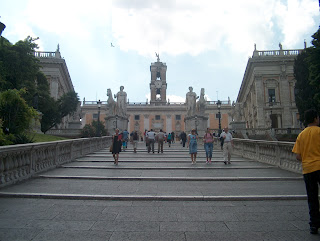The Renaissance was underway in Florence and Venice for a century before Rome caught up. They made up for that slow start, however, with a massive rebuilding effort that transformed the look of the city.
The three most influential masters of the Renaissance in Rome were Raphael (painter), Bramante (architect), and the great triple threat, Michelangelo (painter, sculptor, architect).
 |
| Piazza del Campidoglio |
You can see Michelangelo's architectural work at the Campidoglio, where he redesigned the piazza (including the unique geometric paving) and added new facades to the buildings facing it (today these buildings are the Capitoline Museums and the office of the Mayor of Rome). He also designed the great staircase that leads up to the piazza, the Cordonata.
Not far from the Campidoglio you can see one of Michelangelo's most famous sculptures,
Moses, at San Pietro in Vincoli. This church is named after its most famous relics, the chains (vincoli) that are believed to have shacked St. Peter while he was held in the Mamertine prison.
 |
| Michelangelo's Moses |
Of course, his most famous sculpture is the Pieta, located inside St. Peter's Basilica.
 |
| Michelangelo's Pieta |
The Sistine Chapel holds Michelangelo's two most famous paintings (actually one fresco and one painting), the
Creation of the World and the
Fall of Man on the ceiling, and
The Last Judgment over the altar.
 |
| The Last Judgment |
Although many (if not most) of the great architects of the Roman Renaissance and Baroque periods had a hand in St. Peter's Basilica (including Michelangelo, who was responsible for the magnificent dome), the first and principle architect was Donato Bramante. Although he also had a hand in the design of Santa Maria della Pace, Bramante is probably best known for, and represented by, the Tempietto (little temple) at San Pietro in Montorio. This small circular building is generally considered to be the first true Renaissance building in Rome.
 |
| Bramante's Tempietto |
Better known for his frescos, Raphael also worked as an architect in Rome, notably on the Chigi Chapel at Santa Maria del Popolo. His frescos for the private apartments of Pope Julius II are together known as the Raphael Rooms. The work on these four rooms took over 16 years and Raphael died before it was completed, but they remain perhaps the best expression of the religious and philosophical ideals of the Renaissance.
 |
| Raphael The Fire in the Borgo |







No comments:
Post a Comment